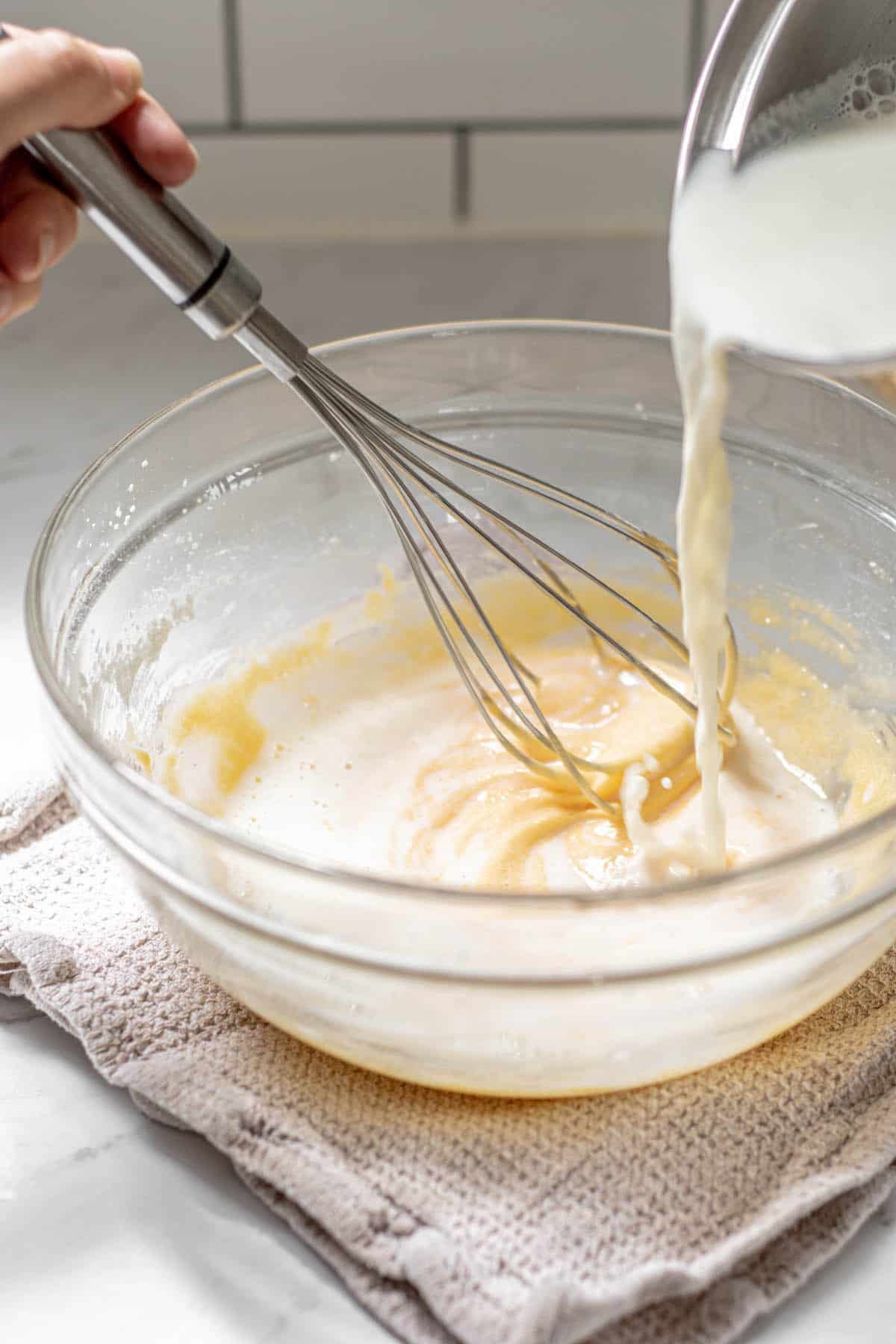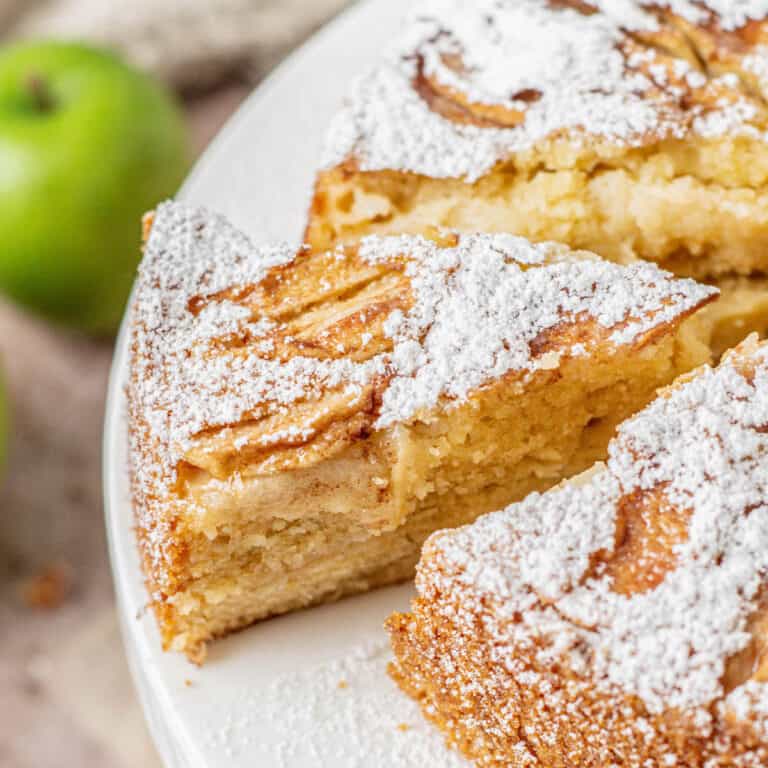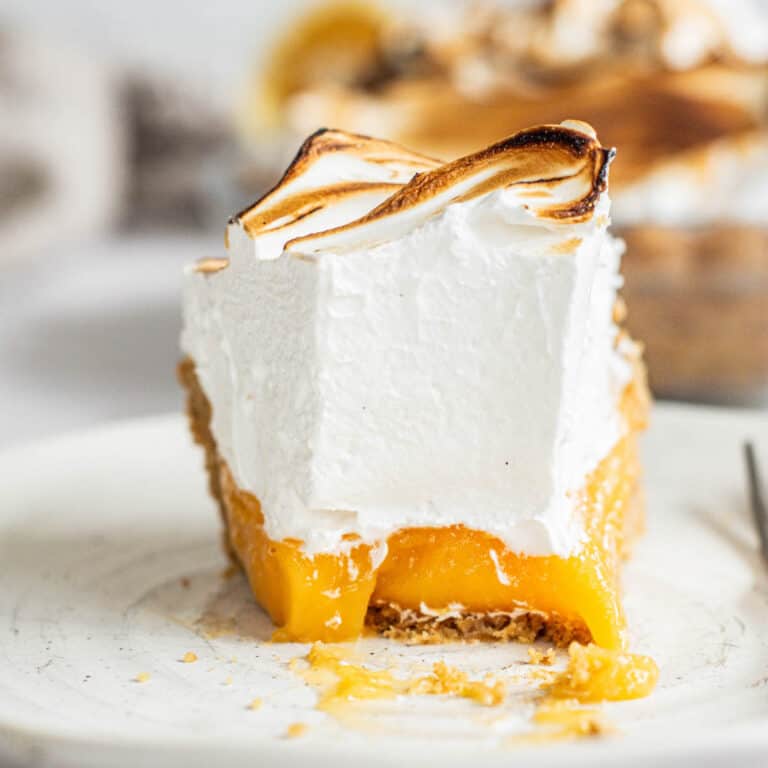How To Make Crème Pâtissière
Crème pâtissière, also known as vanilla pastry cream, is the unsung hero in so many French desserts. This is the perfect custard filling for cake, choux buns, Boston cream pie, fruit tarts and more.

This creamy custard is so easy to make, and a great base recipe to have up your sleeve.
You can also turn a crème pâtissière into different creamy fillings like creme diplomate, or creme mousseline, crème légère, or chiboust cream by adding things like whipped butter, whipped cream or meringue.
Ingredients
Making classic crème pâtissière begins with simple ingredients – It’s fast too! You just need to account for chilling time
- Whole milk: The base of the custard.
- Sugar: Just an ordinary granulated white sugar.
- Cornstarch: The thickener.
- Large egg yolks: Brings a rich, luxurious texture. Leftover egg whites can be saved and used for meringue!
- Vanilla: For that deep, aromatic flavor. You can use a scraped vanilla pod, vanilla extract or vanilla bean paste.
- Salt: Flavor enhancer
- Butter: The butter adds a little shine and richness and enhances the creamy texture.

Method

Step 1. Begin by warming your milk and vanilla. In a medium saucepan, heat the milk on medium heat until it is just at a simmer – don’t let it boil.
You’ll see a collection of tiny bubbles accumulating around the edge of the saucepan.

Step 2. While the milk is warming, in a separate bowl, add the egg yolks, sugar, salt and cornstarch. Whisk them together until glossy and smooth.
Place the bowl on a dampened kitchen towel to stop it from slipping around for this next step.

Step 3. Once your milk is infused and hot, it’s time for tempering the eggs.
Add the hot milk mixture in a steady stream to the egg mixture while whisking vigorously.
This step is to prevent the egg yolks from curdling.

Step 4. Return the combined mixture to the saucepan over medium heat. Cook the vanilla custard, whisking constantly until it starts to bubble.
Once it starts bubbling, it will begin to thicken. Keep it at a bubble don’t stop whisking for around 1 minute.

Take it off the heat and whisk in the butter until completely combined.
Pour the hot pastry cream into a clean bowl. If you want an extra silky smooth texture, you can push it through a fine mesh sieve first

Lay a piece of plastic wrap directly onto the surface of the custard to avoid a skin forming and let it come to room temperature.
Then, chill it in the refrigerator.

Top tip for crème pâtissière success
- Cook it long enough. It’s crucial to cook the mixture long enough to deactivate amylase, an enzyme in egg yolks that can break down starch and cause the custard to turn runny as it cools. Once the custard thickens and bubbles appear, you must cook and whisk continuously for a full minute. This will neutralize the amylase.
Other flavors of Crème Pâtissière
- Chocolate crème pâtissière:
- Whisk a tablespoon of cocoa powder in the egg yolks, sugar and cornstarch mixture. Then continue with the recipe. After you have cooked the pastry cream, while it is still hot, whisk in 100-150 grams of finely chopped dark chocolate until it melts completely into the cream.
- Coffee crème pâtissière:
- Dissolve 2 tablespoons of instant espresso powder in the hot milk.
- Citrus (lemon or orange) crème pâtissière:
- Add the finely grated zest of one lemon or orange to the milk before you heat it. Strain the cooked custard if you prefer it without zest bits.
- Pistachio crème pâtissière:
- Mix in 2-3 tablespoons of pistachio paste to the cooked crème pâtissière and whisk until fully incorporated. You can add a drop of green food coloring if you want a more pronounced color.
- Raspberry or strawberry crème pâtissière:
- Puree fresh or frozen raspberries or strawberries and strain to remove seeds. Fold the strained puree into finished and cooled pastry cream.
Fun fact – Pastry cream is often confused with its cousin, crème anglaise. The main difference lies in the consistency: crème anglaise is a pourable sauce, whereas crème pâtissière is thick enough to hold its shape.
Serving suggestions
- Fillings: Pipe this vanilla pastry cream into choux pastry for classic cream puffs or eclairs. Or use it to stuff doughnuts!
- Custard filling for cake. Alternate layers of pastry cream with fruit puree in layer cakes.
- Dessert base: Use it as the base for fresh fruit tarts. Spread it onto a baked pastry case, then top with fresh fruit.

FAQS
Lumps can occur if the egg mixture is not tempered properly or if the mixture was heated too high too fast. Cornstarch must be heated to thicken, but if it’s heated up too quickly, the starch granules can form a shell before fully absorbing the liquid and create lumps. If this happens, simply pass the cooked custard through a fine-mesh strainer to remove the lumps.
Crème pâtissière can be used as a filling for eclairs, cream puffs, fruit tarts, and Danish pastries. It can also be layered in trifles, used in Boston cream pie, spread onto sponge cakes before rolling for a Swiss roll, or simply served with fresh fruit.
Yes, if crème pâtissière is cooked for too long, especially at a high temperature, it can curdle and separate. The eggs can scramble from excessive heat, resulting in a grainy texture. Cook it over medium, or medium-low heat and whisk it while it’s bubbling for around 1 minute, then remove it from the heat.
You can freeze creme patissiere, but upon thawing, it may separate and appear curdled. To fix this, you can reheat the thawed creme on the stove until hot, and whisk until smooth. Or, heat a small portion in the microwave until hot and then whisk it into the rest of the custard until you get a smooth consistency.
If your custard was thick on the stove and only became runny after cooling, then it’s likely it wasn’t cooked long enough. Once it comes to a bubble, it needs a full minute of cooking. You can reheat the custard and cook it longer to fix this.

Crème Pâtissière Recipe
Ingredients
- 480 g whole milk
- 1 vanilla bean or 2 teaspoons vanilla paste or extract
- 65 g granulated sugar
- 30 g cornstarch
- 4 large egg yolks
- 1/4 teaspoon salt
- 45 g unsalted butter
Instructions
- In a medium saucepan, heat the milk and vanilla on medium heat until it is just at a simmer – don't let it boil. You'll see a collection of tiny bubbles accumulating around the edge of the saucepan.
- While the milk is warming, in a separate bowl, add the egg yolks, sugar, salt and cornstarch. Whisk them together until glossy and smooth.
- Place the bowl on a dampened kitchen towel to stop it from slipping around for this next step. Once your milk is infused and hot, it’s time for tempering the eggs.
- Add the hot milk mixture in a steady stream to the egg mixture while whisking vigorously. This step is to prevent the egg yolks from curdling.
- Return the combined mixture to the saucepan over medium heat, whisking constantly until it starts to bubble.
- Once it starts bubbling, it will begin to thicken. Keep it at a bubble don't stop whisking for 1 minute.
- Take it off the heat and whisk in the butter until completely combined.
- Pour the hot pastry cream into a clean bowl. If you want an extra silky smooth texture, you can push it through a fine mesh seive first
- Lay a piece of plastic wrap directly onto the surface of the custard to avoid a skin forming and let it come to room temperature. Chill it in the refrigerator until completely cold.
- When ready to use, give it a whisk to loosen it up again as it will get very thick in the fridge. Crème pâtissière can be stored in the refrigerator in an airtight container for up to 3 days.





